“The future is now” - Nam June Paik
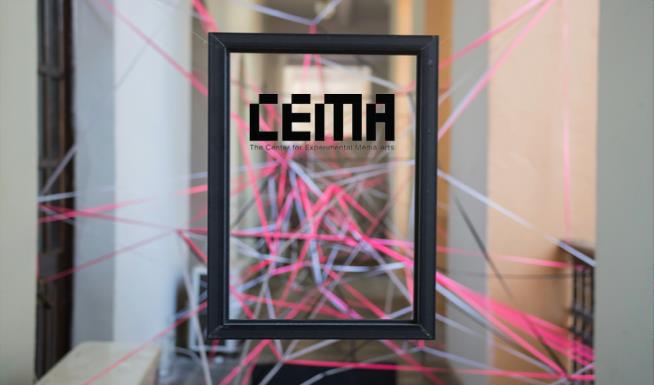
About CEMA
The Centre for Experimental Media and Arts (CEMA) was founded with the support of the Sir Ratan Tata Trust in 2007 by Dr. Geetha Narayanan (SMI Honorary Director), and artists Zack Denfeld, Gabriel Harp and Yashas Shetty (now leading (Art)ScienceBLR, a public laboratory for artists and designers at SMI).
CEMA emerged out of the interests and concerns of artists, designers and academics at the Srishti Institute of Art Design & Technology. In 2004 ‘Force’, a new media arts festival, was hosted in conjunction with the World Information City conference to explore new technologies, future communication environments and their implications. Thereafter, in 2006 Dr. Geetha Narayanan curated the exhibition ‘Tana-Bana –Designing Substantive Freedoms’ with student work led by national and international artists at the prestigious Ars Electronica festival in Linz, Austria. Such initiatives led to the designing of the first graduate program on Experimental Media Art in India (now integrated into the SMI Contemporary Art Practice program).
Born as a hybrid media lab to push the development of media practice and technology, and stretch the limits of our imagination, CEMA provides a radical framework for students to work on interdisciplinary projects.
Vision
The Centre for Experimental Media and Arts (CEMA) is dedicated to artistic and curatorial experimentation with media and emerging technologies. CEMA's research projects facilitate creative practices, critical research and new pedagogies that engage with contemporary culture and society across the following genres and disciplines: art-science, analog and digital technologies, hybrid media, experimental film, video art, sonic art, performance art, media activism and public art.
Through creating a supportive environment for transdisciplinarity and experimentation, CEMA is committed to facilitating social change through the arts and offering open access to education.
Research Areas
Over the years, CEMA’s research areas have evolved to respond to the multiple ways in which emerging technology and new media have intermingled with contemporary artistic production in the 21st century. The range of practices facilitated through CEMA have always been path breaking and at the cutting edge. Some of the key areas of artistic research are:
- Biology
- Space/Science/Cosmology
- Environment and Eco-Art
- Food and Politics of Food
- Information and Activism
- Built Environment/Public Pedagogy
- Critical Social Practice
- Citizen Science
- Technology and Art
- Living Labs
- Innovation and Emerging technologies
- Information Ecology (Tangible media and Networks)
- Public Art
- Human factors and Applied Cognition
Selected Projects
CEMA has been instrumental in attracting international artists-in-residence, and has nurtured an exchange of ideas and skills with a wider community of practitioners through research projects, symposiums, exhibitions and workshops. Some of these are outlined below.
Bio-Art Workshop
Led by Oron Catts of SymbioticA and Greg Cozens from the University of Western Australia, India’s first Bio-Art Workshop for artists interested in Art-Science, was organised by artist in residence Yashas Shetty in collaboration with the National Centre for Biological Studies (NCBS) and The Arts Catalyst in 2008. This hands-on workshop demonstrated how the tools of modern biology can be engaged with by artists to explore the broader philosophical and ethical exploration implications of the interaction of human life with other living things. SymbioticA is an artistic laboratory dedicated to the research, learning, critique and hands-on engagement with the life sciences based in Australia.
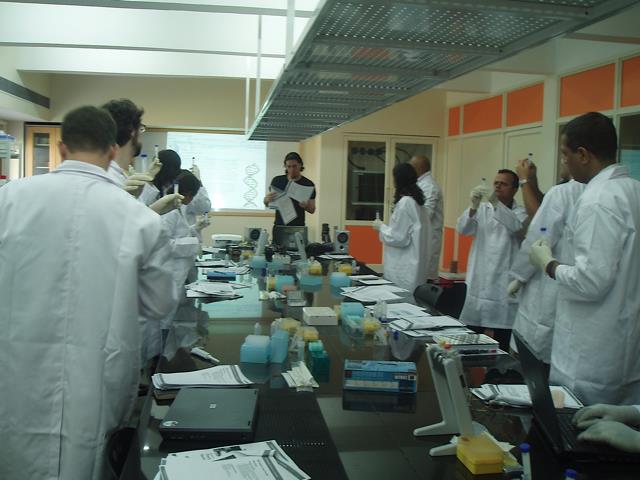
Art-Science Workshop with Oron Catts in progress
Kalpaneya Yatre, festival of Astronomy
Curated by Srishti faculty and artists alongwith scientists from a consortium of Institutes in Bangalore in 2010, this festival explored innovative ways of exhibiting and communicating concepts in astronomy. The festival was an extension of the Moon Vehicle project by artist in residence Joanna Griffin, which began at the time of the launch of India's Chandrayaan-1 spacecraft. The project was focussed on facilitating events that initiate dialogue about the Moon, technologies, science and creativity. A collaboration with J N Planetarium (BASE) Bangalore, Indian Institute of Astrophysics, Bangalore, ISRO Space Applications Centre, Bangalore, Raman Institute of Physics, Bangalore Visvesvaraya Industrial & Technological Museum (VITM).
Video available at https://www.youtube.com/watch?v=9dfP6lzTWB4
The APL (Autonomous Public Laboratory)
A prototype for a people’s research Laboratory was showcased at the India Art Summit in New Delhi 2012. It is a mobile community laboratory for "outsiders" to engage with the rituals and narratives of the science laboratory. The APL is furnished with hacked and repurposed consumer electronics that are re-appropriated as performative and scientific tools. The APL functions as an autonomous space to investigate microscopic and macroscopic organisms (both biological and technological) that inhabit a city. Concept and artistic direction by artist Yashas Shetty
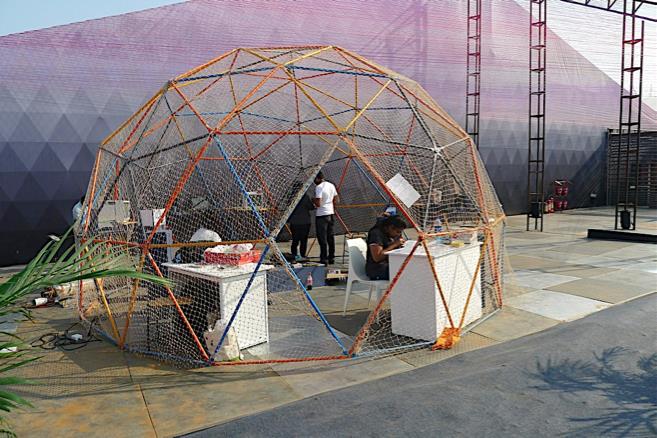
The APL (Autonomous Public Laboratory) installed at the India Art Summit in New Delhi 2012
BEAM
A multi-channel sound installation and performance in Bangalore and Kochi conceived by Dr. Cathy Lane in collaboration with Creative Research in Sound Art Practice, LCC, London. Created and executed with students and faculty, BEAM was composed from archival material and maritime radio communications through the sonic translation of AIS (Automatic Identification System) data. BEAM was exhibited as a Collateral Event during the Kochi Muziris Biennale 2014.
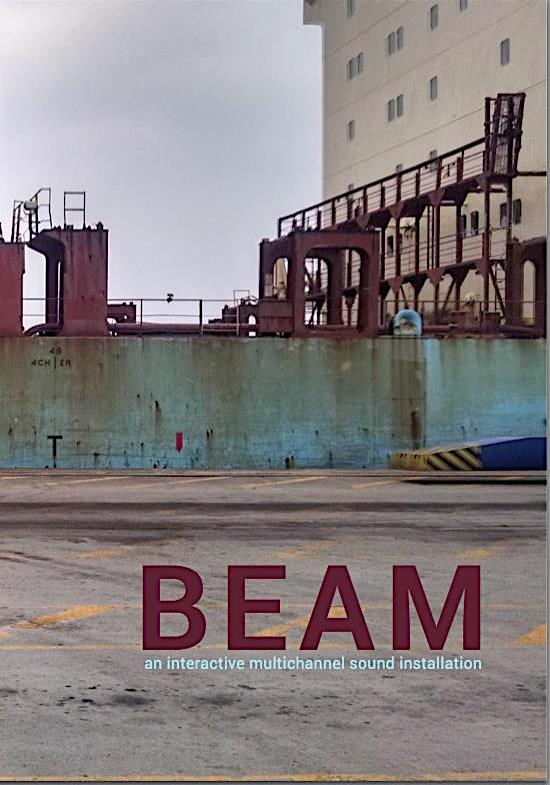
BEAM at Artry Gallery Kochi, Collateral Event Kochi Muziris Biennale 2014
The Entanglement- A Dance Between Art And Science
Showcased at the Serendipity Arts Festival (2016) in Goa, this project was part of Science Gallery Bengaluru’s pop-up exhibition on the theme of Art and Science. The exhibits were also presented as part of ITBIZ conference in Bangalore, and was jointly funded by the Department of IT, BT & Science and Technology, and Biocon Limited. The following projects were developed at CEMA for the exhibition.
a) The Blue Dot
The Earth’s seismic activity reflects the status of our planet. It is Earth’s vocalisaton and a reminder that the planet is still going through its evolutionary process with the rest of the universe. The project uses real-time earthquake data (from USGS, NEIC and other agencies) to render the quantitative characteristics into a visual, sonic, and interactive installation. Artists: Sai Krishna Mulpuru, the late Abhiyan Humane, Tejaswi Meshram, Anoop Saxena
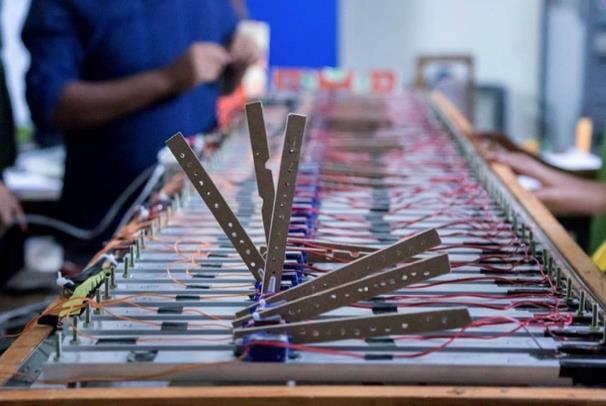
The Blue Dot exhibited at the Serendipity Arts festival (2016)
b) Think Tank
This installation is a direct physical representation of the complex networking in the brain, depicting thoughts as rain drops, and memory as a tank of water. Think Tank is a system, built using advanced brain sensors (EEG) and electronics that can capture the action potentials fired in the pre-frontal cortex, which interactively simulates thunder, lightning and rain. Artists: Sai Krishna Mulpuru, the late Abhiyan Humane, Tejaswi Meshram, Anoop Saxena
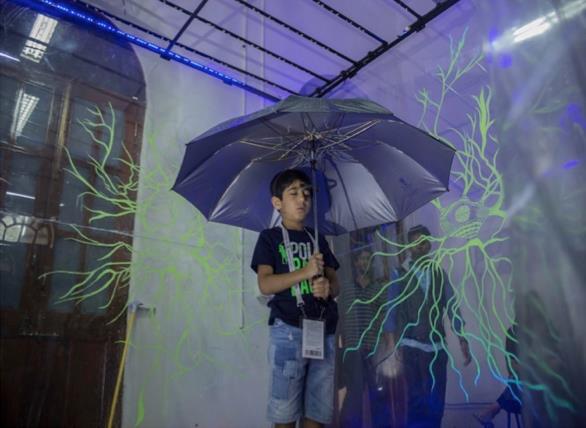
Think Tank exhibited at the Serendipity Arts festival (2016)
Srishti LIVE - a Festival of Ideas and Performances
Started in 2004 as a curatorial project by curator Meena Vari, Srishti Live is an annual event at Srishti through which students get the opportunity to work intensively alongside contemporary artists invited from India and around the world. Through socially engaging and context specific art and design projects, students are led beyond the campus and classroom into public spaces. Artists and designers working in visual arts, design and performance, installation art, film, experimental and new-media arts are invited each year to participate for this one-month long residency during the interim semester. So far 164 -170 artists have shared their artistic practice with students of Srishti during the Srishti Interim Festival of ideas and Festival of Performances.
The following are examples of projects at Srishti LIVE 2019:
Our Scenery
A public installation by artist Risa Sato (Japan) who worked with Srishti students to create new sceneries by adding a foreign object to a regular scene, making it disappear and allowing for something new to appear. After digitally documenting locations, the students created patterns that were stitched into inflatable materials and placed in different locations to create new sceneries.
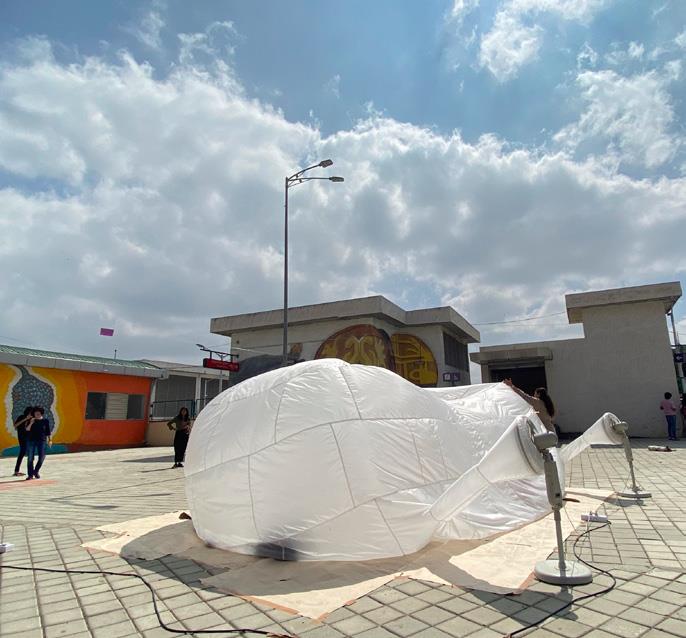
Our Scenery installed outside Chickpet Metro Station, Bangalore
The Falls
An installation in five parts by artist Allan Parker and Srishti students which includes screen-printed banners, prints on the risers of a staircase, a film, a large format book and a laser and sound installation. As a whole, the work reflected on the creation and development of cities, what it takes to sustain them and the effects they have on the wider environment. Concerns over water supply, pollution and the longevity of the built environment are often overshadowed by the desire for progress and the prospect of a golden future.
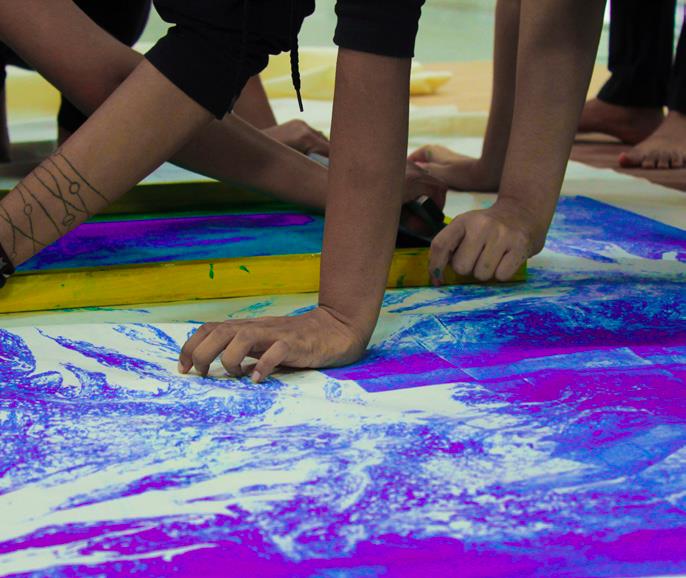
Students working on The Falls installation
Fabric Ecologies
Artist Lavanya Mani and students developed a set of installations that address contemporary ecological concerns including the fragility of our ecology, the pollution of lakes and the slow demise of endangered species and trees in Bangalore. Students were taught a range of surface application techniques on textile, including shibori, tie and dye, rust printing and other techniques of natural dyes with flowers and plant materials.
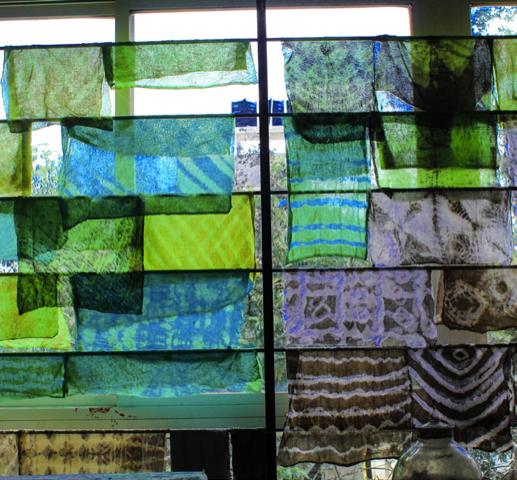
Fabric Ecologies installation
Current Research & Opportunities
SMI Media Archive
The SMI Media Archive is envisioned as a space devoted to nurturing discourse and facilitating practice based research. The archive will offer access to the decade long history of work by Srishti artists and designers who continue to participate in the evolution of media art and technology in India.
The SMI Media Archive invites students, scholars, artists, filmmakers and curators to develop research projects and contribute to building the archive through the following pathways:
- Accessing and contributing to the collections of films, videos and media art
- Accessing and contributing to the library of media art and culture publications that includes books, catalogues, journals, magazines and pamphlets
- Short term research fellowships and residencies
- Curatorial projects including film festivals, exhibitions and seminars
The SMI Media Archive is freely accessible to researchers and practitioners who are interested to pursue research through the following lines of inquiry:
- Mapping the history of artists’ moving image and media art in India
- Investigating questions around analog and digital technology
- Exploring curatorial practice on intersections between the arts, technology and society
Partnerships
- NCBS (National Center for Biological Sciences), BANGALORE
- Science Gallery Bengaluru (SGB)
- Tate UK
- Kochi Biennale Foundation
- Chennai Photo Biennale
- Indian Sonic Research Organisation
- The Arts Catalyst [LONDON] – Arts and Science Agency based in London
- CRISAP (LCC, London) – Creative Research in Sound Art Practice
- CSTEP (Bangalore) - Center for Science, Technology and Policy
- Institute of Astrophysics (Bangalore)
- Jawaharlal Nehru Planetarium (Bangalore)
- Visvesvaraya Industrial & Technological Museum, (Bangalore
- Indian Space Research Organisation (ISRO, BANGALORE)
- NIAS [Bangalore] – National Institute for Advanced Studies
- Leonardo [USA] – Leonardo Journal for the Arts, Sciences and Technologies
- SymbioticA (Australia) - An artistic research lab at the University of Western Australia's School of Anatomy and Human Biology.
- National Center Experimental Arts and Media UNSW [Australia]
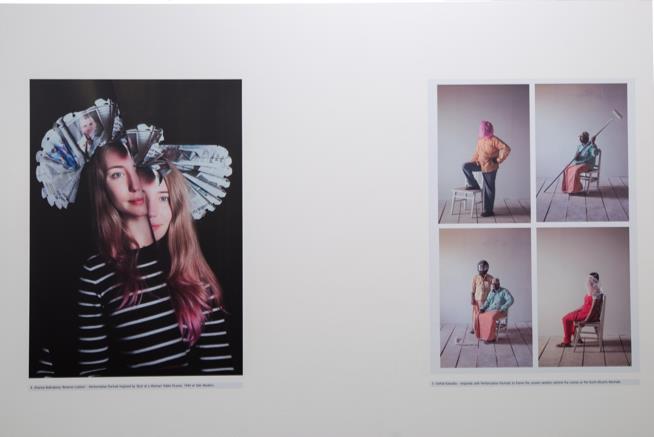
Global Art Space- Exhibition at Tate UK, London (collaboration with Kochi Muziris Biennale and Central St Martins, UK)
Collaborations within Srishti
Art In Transit
Art in Transit is a public art initiative with the aim to facilitate meaningful discourse, research and practice of art, design, technology in spaces of transience.
(Art)ScienceBLR
(Art)ScienceBLR is a public laboratory for artists and designers to engage with scientific practices by looking at the artistic, social and political implications of technologies, from computing to biotechnology.
Blank Noise
Over a sixteen year period, Blank Noise has grown from being a student led project to an international network of ‘Action Heroes’: citizens committed to tackling street harassment and to changing public attitudes towards sexual violence.
The Kabir Project
Inspired by the spirit of Bhakti, Sufi and Baul traditions of mystic poetry, the Kabir Project has been engaged for the last 15 years in many journeys exploring the power and relevance of this poetry and music for our times.
Outreach Activities
- 2007 Bangalore Space Culture Conference, organised by Yashas Shetty in collaboration with NIAS, Bangalore
- 2008 Art-Science Workshop led by artists from SymbioticA, Australia, organised by Yashas Shetty in collaboration with the National Center for Biological Sciences.
- 2010 Astrofest (Kalpanaye Yatre) initiated by artist in residence Joanna Griffin
- 2011-2013 Outresourcing research project with Transmediale by Prayas Abhinav
- 2012 CEMA at the India Art Fair – Autonomous Public Laboratory by Yashas Shetty
- 2014 Story of Light Festival, Goa, concept and artistic direction by the late Abhiyan Humane
- 2014 Collateral Presentation at Kochi Biennale 2014 curated by Meena Vari
- 2015 ITBiz exhibition of Art and Science, Curated by the late Abhiyan Humane
- 2016 - Serendipity Art Festival in collaboration with Science Gallery International and Science Gallery Bengaluru, curated by the late Abhiyan Humane
- 2016 - Srishti Outpost at Mill Hall collateral event at Kochi Biennale curated by Meena Vari
- 2014 and 2016 - Presentations at the Tate, UK, a collaborative project at Tate Exchange curated By Meena Vari
- 2017 - Talks by national and international artists organised by Marialaura Ghidini
- 2018 - Presentations at the Chennai Photo Biennale curated by Meena Vari
- Srishti INTERIM Festival of Ideas and Performances 2004 to 2019, curated by Meena Vari


Rustle TV (2004), a broadcast experiment in Russel Market Bangalore produced as a workshop for students by artist Shaina Anand (CAMP), Mumbai
Artists & Curators in residence
- Gabriel Harp
- Yashas Shetty
- Joanna Hoffmann
- Joanna Griffin
- Zackery Denfield
- Allison Kudla
- Sharath Chandra
- Prayas Abhinav
- Late Abhiyan Humane
- Smriti Mehra
- Ron Schneider
- Labomedia Collective France: (Ewen Chardronnet, Benjamin Cadon, Alexander Roemer, Loreto Martinez Troncoso, Hélène Chaudeau, Gepeto Girault)
- Kristoffer Gansing
- Cathy Lane
- Thomas Heidtmann
- Rob La Frenais
- Galerie C&V- Alexander Mayer, Jo Zahn and Joern Zehe
- Marialaura Ghidini
